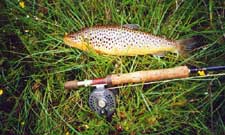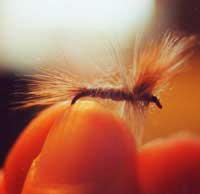Making the most of Mayfly

By Lesley Crawford
 "I'm all fished out!" exclaimed my American guest aptly summing up another spectacular day of angling for trout during the Caithness mayfly season. "I'm all fished out!" exclaimed my American guest aptly summing up another spectacular day of angling for trout during the Caithness mayfly season.
These graceful lace winged insects carpet most of our lochs at this time of year and the phenomenon causes big trout to rise and anglers hearts to beat a little faster. On many trout lochs in the northern highlands of Scotland the mayfly hatch begins in very early June and runs to mid August. That's two months of trout heaven.
Despite misinformation about the propensity of mayfly to hatch only in Ireland or the hallowed chalkstreams of England, there are very few of our northern waters which fail to see some mayfly activity. Hatches will vary from a trickle of a few thousand to billions of flies and hatch numbers depend both on the water environment and the local conditions.
When in their nymph stage, mayfly require a clay like mud to make their burrows and as Caithness has an abundance of marl (a pale clay like mud) this provides an ideal environment for the insects to thrive. The abundance of the hatches will be affected by the local weather however, for example if we have a very dry May and June the marginal homes of the mayfly can dry out and the insect fails to emerge. Fortunately for anglers this doesn't happen too often!
Scottish mayfly have an odd and ultimately sad lifecycle first spending up to two years as a nondescript burrowing grub in the marl margins of Caithness lochs before slowly emerging to the surface as a semi transparent brownish colored nymph. If you are wading you can often scoop up a nymph or two in your hand. They are about an inch or so long sometimes bigger with a peculiar looking faintly blue 'head' and an elongated 'body' and in this form they give no clue of the beautiful insect about to emerge.
As the nymphs float up to the surface you can sometimes see the wing cases split and the fully fledged insect wriggle and emerge. Conditions have to be pretty still to observe this but its an amazing sight. Once the mayfly (known as dun at this stage) are on the water you will see the familiar flotilla of three tailed upright winged insects adrift and big trout cruising around busily snapping them up.
Those mayfly which do escape the fish, take to the air and scutter off the water to attach themselves to heather or trees there to dry their wings for a period of about two days. Then the mating dance of mayfly 'spinners' begins at the side of the loch. The males form dense clouds awaiting the females and once paired off they will mate over the water with the female depositing her eggs back into the loch. Both then die and this is known as the 'fall' with the trout again rising madly at the spread-eagled insects limp and lifeless on the surface.
 Not only is July an intense period of activity for insects, its an intense time for anglers as they attempt to winkle out those larger trout which rarely rise for the rest of the season. Not only is July an intense period of activity for insects, its an intense time for anglers as they attempt to winkle out those larger trout which rarely rise for the rest of the season.
Fly choice becomes critical for though we can argue that because the trout are feeding well, the fish will take just about any pattern, this is by no means always the case. To be consistently successful you will need to put on a fly to imitate local insects and when the trout get fussy a reasonably exact imitation in terms of shape and color is nearly always more useful than a general attractor pattern.
On a number of Caithness waters there appears to be two distinct types of mayfly, one the classic 'green drake' with upright olive lace wings and olive body, the other has a distinctively darker brown and yellow body and black veined wing. It is possible the former is the paler female while the male is darker, however there is a degree of doubt about this because it seems the emerging dun is paler than the spent spinner.
Whatever the cause of the coloration its nice to match your fly to the natural. To this end I have developed a few favorites for use during this dramatic time. For nymphs I use a large Hares Ear fished slowly though I often use a dry fly as a top dropper with it as trout seem more intent on the hatched insect rather than solely its underwater form.
For the emerging greenish mayfly I use the Rough Olive and also the French Partridge with an additional olive tinted head feather rather than just all grey. For the darker mayfly fall I use the Grey Wulff and occasionally the dry Wickhams.
When there are many spent spinners I use any mayfly imitation which has the classic spent wing. If things do not need to be too exact I can get by with a Golden Olive Bumble (Irish fly) or a Loch Ordie (Scottish) made dry with a smear of floatant. Of this selection fished in size 10 or 12, the most useful is probably the French Partridge with an olive hackle and a downward pointing brown tail. This fly was given to me by fellow UK author Geoffrey Bucknall and it has been extremely successful over several seasons.
 Traditional French Partridge are tied without a prominent tail and I am convinced this addition gives the fly a more 'sit up and beg' quality which trout find supremely attractive. The Grey Wulff (pictured) has a similar downward pointing tail and it brings similar smash and grab results. Traditional French Partridge are tied without a prominent tail and I am convinced this addition gives the fly a more 'sit up and beg' quality which trout find supremely attractive. The Grey Wulff (pictured) has a similar downward pointing tail and it brings similar smash and grab results.
When its windy you can use two or three of these flies on droppers in a traditional loch style cast however remember to space out droppers (up to 6ft apart) otherwise trout look at nothing but nylon and knots. In calmer conditions a single fly is often better as without some cover our intentions are far too obvious. Fish the dry flies semi static or with a gentle twitch retrieve.
Make the most of mayfly time. Even if you do get 'fished out' it's a pleasurable state of exhaustion and most fishers would not have it any other way.
Hope to see you in 2002!
To find out more check out Lesley's web site on www.wildtroutfisher.co.uk
Click on any of the above photos for larger version,
remember to use your browser's back button to return.
|

